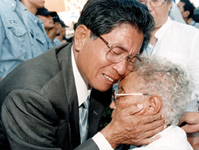By Ellyn Pak
Photos courtesy of Saemsori
In just a few moments, Samuel Kim lost everything that he had known in his 19 years of age.
The Korean War began in 1950 and like other refugees, Kim’s family attempted to flee from Pyongyang, North Korea to the south.
But one misstep on a road carrying thousands of fleeing families separated Kim from his parents and 14-year-old brother. He continued to march south and later enlisted in the South Korean army.
He would never see his family again.
Fifty-nine years later, those memories still haunt Kim, who is now 78 and lives in Glendale, Calif.
It was by chance that Kim was able to reconnect with his brother, Byung Kook. A friend in Los Angeles was given a rare opportunity in 1990 to visit North Korea and look for his family members.
After his trip, Kim’s friend received North Korean newspapers, mostly filled with propaganda, and found an article that a man in the northern part of the country was looking for his long-lost brother.
Kim discovered the man was his younger brother and sent him a letter.
After a year of waiting for a response, Kim finally received a letter back. “I can’t express it,” Kim says. “It was a long time since I was separated from him. I cried, no doubt.”
He learned that his father died soon after the family was separated. And his mother passed away in 1976 from a stroke. Byung Kook, now 73, lives about 80 miles north of Pyongyang in North Korea.
Kim, who moved to the U.S. in 1966, doubts he will ever be reunited with his brother. While they continue to exchange a handful of letters each year, they have yet to speak on the phone. At Kim’s age, he cannot easily travel to North Korea. He worries that after he dies, his children may not try to find their uncle.
But Kim is one of the lucky few to have had at least some contact with a long-lost relative in North Korea. Many others do not have that chance.
Saemsori, an organization based in Washington, D.C., is working to document the stories of older Korean Americans like Kim and encourage families to contact U.S. Congress members to put the issue of reunions on the front burner.
There are an estimated 200,000 Koreans in the United States who have family members in North Korea, the majority of whom were separated during the Korean War. Those who are looking for their loved ones are part of an aging population that continues to dwindle each year.
Stories of emotional reunions are also decreasing, as the rift between North Korea and the U.S. widens and the ability of elderly Korean Americans to safely look for their family members decreases.
The nonprofit has yet to facilitate any reunions, which are often hampered by bureaucracy and the inability of Korean Americans to get access to North Korea, says Saemsori director Alice Jean Suh.
South Korea is more successful with brokering reunions and reserves them only for its citizens, Suh says. Korean Americans, who are neither South Korean citizens nor North Koreans, are often left in the shadows.
Saemsori is working to gather the names of Korean Americans looking for family in North Korea in case reunions are permitted in the future.
“How do you explain to a grandmother, ‘You can’t see your sister because of political reasons,’” Suh says. “This population is finally realizing that they’re running out of time. They want to find out what happened to their family before they die.”
***
Saemsori, which translates as “the sound of a stream,” was created in February 2006 as an offshoot of the EugeneBell Foundation, a nonprofit organization that provides humanitarian and developmental aid to those in North Korea.
The foundation is also a resource for those who want to provide medical assistance, particularly to combat tuberculosis.
Stephen Linton, who grew up in South Korea in a family of Southern Presbyterian missionaries and is a fluent Korean speaker, founded EugeneBell in 1995 and has since traveled to North Korea more than 60 times.
“One of the things that is troubling to me is that Korean Americans can’t enjoy the same access to North Korea than I can as a non-Korean,” Linton says.
Korean Americans are not considered first-class American citizens and have limited access to North Korea, he says. That view limits the chances of Korean Americans reuniting with their family members.
“There’s no official interest in these problems,” Linton says.
Creating Saemsori was one way to address the many requests the EugeneBell Foundation received to facilitate reunions. Saemsori, which has less than a handful of staffers, now maintains a database of Korean Americans, DNA samples and stories as a living history for those who may never get the chance to see their loved ones.
So far, the organization has used the database to link elderly Korean Americans with the media so they can recite their experiences. Samuel Kim was one of them. He was interviewed on a CNN broadcast about North Korean refugees.
But for the most part, people have taken interest in missing-in-action cases, human rights issues in North Korea and nuclear tensions, while the pleas of divided families are largely left ignored, Linton says.
“This gives North Korea a distorted view of how we value Korean Americans,” he adds.
Koreans in the U.S. and South Korea have used other conduits, like hiring brokers in China to contact family members, but are often left victimized. And elderly Korean Americans often fear that attempting to contact the North Korean government will endanger their families and leave them vulnerable to prejudice.
“The idea is that this is a long forgotten voice, and it should be heard,” Linton says. “People only want their adopted government to be cognizant of their pain. It involves a kind of engagement with North Korea.”
There is a sense that the Korean American community has recently become energized about voicing their concerns, Linton says. He urges younger Korean Americans to learn about their roots and be a voice for their grandparents.
“The most heartbreaking thing is that [elderly Korean refugees] try for half their lives [to make contact with their families] and die before they can,” Linton says. “I have no way to help them. That’s heart wrenching.”
For now, Saemsori is focusing on an online family history museum for second- and third-generation Korean Americans who want to help tell their grandparents’ stories and continue their legacies. The idea is to get as many stories in the limelight to highlight the need to facilitate communication between the U.S. and North Korea.
At the very least, it is a way to make sure these stories stay alive.
For more information, go to www.saemsori.org.





